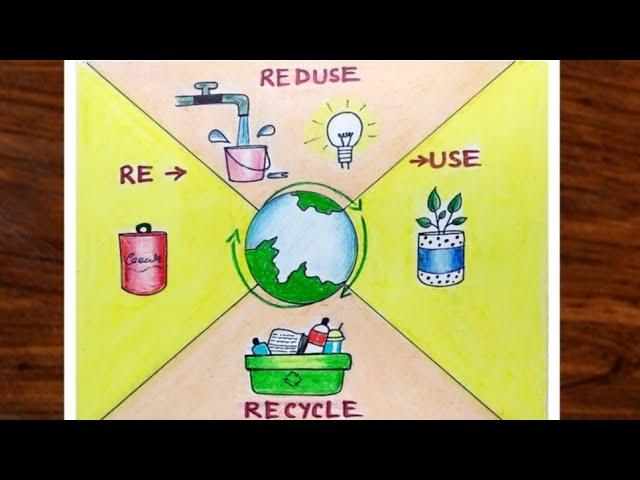💧 Saving and Recycling Water
Water is one of the most precious resources on Earth. Every drop of water we use today has been part of our planet for millions of years. Though the Earth looks blue from space, only about 1% of water is available for human use — the rest is locked up in oceans, ice caps, or deep underground. That’s why it is our duty to use water wisely and recycle it whenever possible.
🌍 Why Saving Water is Important
Water is needed in every part of our life — for drinking, cooking, bathing, cleaning, farming, and producing electricity. Without water, life on Earth cannot exist. Yet, many regions of the world face water scarcity. People in some villages walk several kilometers just to fetch a single pot of water.
If we keep wasting water the way we do today, the future generations might struggle to get clean water for even basic needs. Climate change and growing population are also putting extra pressure on water sources. By saving water now, we can ensure that there is enough for everyone — both today and tomorrow.
Saving water also reduces the energy used to pump, clean, and deliver it. This means less electricity is consumed, which in turn reduces pollution and global warming. So, saving water is not just about conserving a resource; it’s also about protecting the environment.
🔁 What is Water Recycling?
Water recycling means using wastewater again after treating or reusing it in a smart way. It helps reduce the amount of freshwater we use. Not all water that becomes “waste” is truly waste. For example, the water left after washing clothes, dishes, or vegetables can be reused for other household tasks.
In big institutions like airports, hotels, and malls, recycled water is used for cleaning, flushing toilets, or watering gardens. This reduces their water bills and helps save large amounts of fresh water daily.
✈️ Example: Recycled Water in Airports
A perfect example of water recycling can be seen in many modern airports. The water used for washing hands or cleaning floors is collected, filtered, and treated. After treatment, it is not used for drinking but reused for flushing toilets in the restrooms.
This simple system saves thousands of liters of water every day. Imagine how much water would be wasted if all that water simply flowed into drains instead of being reused! This kind of recycling system is a great example of how technology and planning can work together to conserve water.
🪣 Simple Water Recycling at Home
Even at home, we can recycle and reuse water in small but meaningful ways. For example:
RO Waste Water:
The water that comes out of the RO (Reverse Osmosis) purifier as waste is actually not useless. It contains minerals and salts, but it can easily be collected in a bucket and used to mop floors, wash clothes, or water outdoor plants.
This prevents wastage of several liters of water every day.
Used Water from Washing Clothes or Vegetables:
The leftover water after washing clothes or rinsing vegetables can be used for cleaning the house or flushing toilets. It is not suitable for drinking but perfect for cleaning purposes.
Rainwater Harvesting:
We can collect rainwater from rooftops in a storage tank and use it for watering gardens or cleaning vehicles. Schools and societies can install rainwater harvesting systems to recharge groundwater.
Fixing Leaks:
A dripping tap can waste up to 20 liters of water per day. Checking and repairing leaks in taps and pipes helps save a surprising amount of water.
Turning Off Taps While Brushing or Washing:
Many of us leave taps open while brushing teeth or soaping hands. Turning off taps during these moments can save several liters every single day.
🌱 How Saving and Recycling Water Helps the Future
Prevents Shortages:
When we save and reuse water, we ensure that there’s enough supply during dry seasons or droughts.
Protects the Environment:
Conserving water reduces pressure on rivers, lakes, and groundwater, helping keep natural habitats safe for plants and animals.
Reduces Pollution:
Recycling wastewater means less dirty water is released into rivers and oceans, keeping them cleaner.
Saves Energy and Money:
Less water use means less energy is required to pump and purify it. This also reduces electricity bills and the carbon footprint.
Secures Future Generations:
The water we save today is the water our children and grandchildren will depend on tomorrow. Conserving it is like saving money in a bank — an investment in the future.
💡 What Schools and Communities Can Do
Install rainwater harvesting systems on rooftops.
Set up greywater recycling plants to reuse water from bathrooms and sinks for gardening or cleaning.
Organize “Save Water” awareness campaigns to teach students and families about conservation.
Encourage everyone to bring their own water bottles instead of using disposable plastic bottles, reducing both waste and water used in manufacturing plastics.
💧 Conclusion
Saving and recycling water is not just an individual task — it’s a shared responsibility. Whether it’s a big airport reusing its washroom water for flushes or a family keeping a bucket under their RO purifier to reuse the waste water, every action counts.
We often take water for granted because it flows easily from our taps. But we must remember that behind every drop, there is a long natural cycle involving rain, rivers, and groundwater. It takes nature years to create what we can waste in minutes.
If each of us makes small changes — like turning off taps, collecting wastewater, or promoting recycling — we can make a big difference. Saving water today means securing life tomorrow. Let us all promise to “Use Water Wisely and Recycle Every Drop.”

